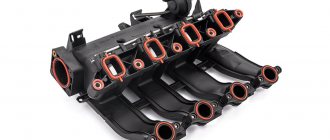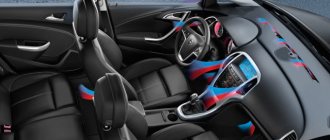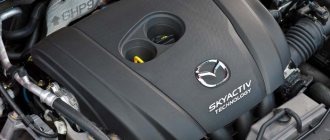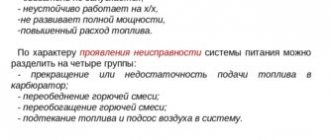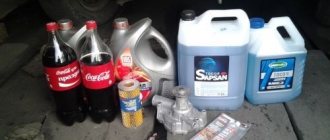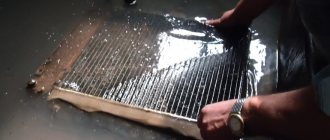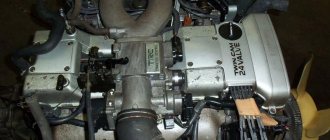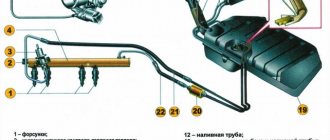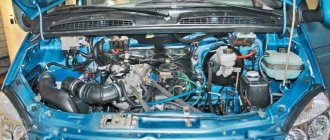Poor fluid circulation
Overheating occurs due to the fact that the liquid does not have time to pass around and release heat into the atmosphere. The culprit turns out to be the water pump. A quick way to check its performance is at idle engine speed. We briefly pinch the hose in the upper part of the radiator, and then release it; when the pump is running, a small water hammer will be noticeable.
Circulation problems due to thermostat
Obstacles in the way of fluid movement slow down its progress. In this case, you will need to flush the system or its individual elements, for example, a radiator or stove. It is necessary to rinse with a stream that will flow in the opposite direction than when the system is operating.
Poor circulation is sometimes to blame for the thermostat or a small amount of coolant.
Corrosion
A large amount of contaminants, suspensions, and debris in the liquid does not contribute to the proper operation of the cooling system.
Clogged cooling channels
To avoid this, it is advisable to use soft water or special liquids. Corrosion can appear in the channels when its solution is incorrectly formulated or the system is rarely flushed and a complete drain is carried out.
Engine cooling system problems and malfunctions photo description
All possible malfunctions of the engine cooling system can be divided into only three groups: 1. The engine overheats. 2. The engine does not heat up well. 3. It's leaking somewhere.
Before considering any cooling system malfunctions, you will need to become familiar with the operating principles of your engine's cooling system. Compression in engine cylinders, as a rule, does not exceed 14 , and more often, unfortunately, it is only a little more than 10 . If the compression were several times higher, your engine would run almost without heating. Can this really happen? Yes. Such a huge compression would make the engine's coefficient of action greater than 90%, the engine would run almost cold. Its just a dream. This abnormally high compression is technically extremely difficult, almost impossible.
This means our engine should warm up.
This phrase is the main one when troubleshooting the cooling system. We cannot dramatically reduce engine heat, we can only provide better cooling to the engine if it is overheating, or ensure normal operation of the cooling system if the engine does not heat up to the desired temperature.
The engine must operate at its designed temperature.
At a lower temperature in the engine, friction increases, the engine lubrication system works worse, the engine wears out faster, and fuel consumption increases. If the temperature is too high, the piston group fails extremely quickly, the chances are very high that the valve system will fail (“burnt out valve”), and if the coolant boils, this can seriously upset your engine. Your engine lubrication system and cooling system should work well. The only thing more important than these two parameters is the car’s braking system.
Checking the cooling system and frost resistance of the coolant
Many serious engine malfunctions are associated with malfunctions of the cooling system. If the car is equipped with an automatic transmission, then its operation and service life are also directly related to the performance of the cooling system.
Checking the cooling system should be done with a cold engine, so it is better to do it before the first trip of the day or no earlier than three hours after turning off the engine.
Slowly, being careful in case the engine is not yet completely cool, remove the expansion tank cap. Rinse it thoroughly inside and out with clean water. Check the cover gasket. A low coolant level may be caused by the cap not being screwed on correctly.
Also clean the filler neck. The presence of signs of corrosion in the filler neck means that the fluid should be replaced. The liquid inside the radiator should be relatively clean and transparent. If it is brownish in color, drain the system and fill it with new fluid.
Carefully check the radiator hoses, as well as heater hoses that have a smaller diameter. Check the entire length of the cooling system hoses, replacing any cracked, swollen or worn hoses. Cracks are easier to detect if you squeeze the hose with your hand. Pay special attention to the clamps that hold the hoses to the cooling system components. These clamps can cut or puncture hoses, causing fluid to leak.
Make sure all hose connections are securely fastened. Fluid leaks usually appear as white or rust-colored deposits in the area of the seal failure. If your car uses wire-type clamps, then it may make sense to replace them with screw-type clamps.
Using compressed air or a soft brush, clean the front of the radiator (and the A/C condenser, where equipped). Remove all insects, leaves and other foreign objects that have fallen on the radiator fins. Be very careful not to damage the ribs or cut your fingers on them.
If the fluid level is constantly dropping and you have not found any leaks, you should pressure check the radiator cap and the entire cooling system.
A noticeable coolant leak and/or presence of oil in the coolant, as well as white clouds in the exhaust gases, indicate a defect in the cylinder head gasket.
Checking the frost resistance of the coolant
Before the start of the winter season, it is necessary to check the concentration of antifreeze in the coolant, especially if clean water was poured into the system during operation.
You will need a special hydrometer with a calibration of antifreeze resistance.
Examination
Warm up the engine slightly until the upper radiator hose warms up. When measuring antifreeze concentration, the liquid temperature should be about +20°C.
When the engine is hot, the expansion tank cap should be opened carefully. There is a danger of burns! You need to place a rag on the cork. Open the cap only when the liquid temperature does not exceed + 90°C.
Carefully remove the expansion tank cap.
Draw up the liquid using a hydrometer bulb.
Typically, the concentration of antifreeze is sufficient to protect the system down to a temperature of –25°C, and in particularly cold climates down to –35°C.
Removing fluid
To remove coolant, place a tray under the radiator and remove the radiator drain plug.
It is impossible to completely remove old fluid from the system (without completely disassembling the engine), therefore all volumes given in the Specifications are conditional. In practice, you can fill the system with about 2/3 of the prescribed amount of liquid.
After filling the system with fresh antifreeze, place a label on the expansion tank indicating the concentration, brand of antifreeze and date of replacement. Any subsequent replenishment of the system (prior to scheduled replacement) must be carried out only with the specified fluid.
Adding antifreeze
If it is necessary to protect the engine down to a temperature of –25°C, the concentration of antifreeze in the coolant should be 40%. If protection is required down to a temperature of –35°C, the antifreeze concentration should be 50%.
If a higher degree of freeze protection is required, the antifreeze concentration level can be increased to 60%. This concentration will provide protection down to –40°C.
If the concentration increases to a higher level, the degree of engine protection begins to decrease and, in addition, the heat dissipation properties of the coolant deteriorate.
Air jams
If the engine overheats after changing the fluid, the reason is most likely due to air pockets in the system. These plugs prevent fluid from circulating throughout the system. They appear as a result of too hasty refueling of the system.
If you think there are air pockets in the system, first try to compress all visible hoses one by one. You can immediately determine whether the hose is filled with liquid or air. As a rule, all air pockets disappear after the first (after replacing the fluid) engine start.
With the warm engine running, turn on the heater and its fan. Warm air must enter the cabin in sufficient quantity. If the supply air temperature is low, an air lock may be the cause.
The consequences of air locks in the system can be very serious (not just a decrease in the efficiency of the heater). A large plug can stop the circulation of fluid inside the engine. To make sure there are no blockages inside the engine, touch the upper radiator hose with the engine running - it should be hot. If the hose is cold, this indicates an air lock in the engine or a faulty thermostat.
If you are unable to get rid of air pockets, allow the engine to cool completely, remove the expansion tank cap, and try compressing the system hoses. If this does not help, drain all the coolant into a clean container and refill the system with the same liquid, following the recommendations above.
Part 1. The engine is overheating.
The engine ALWAYS tries to warm up more if the compression is too low, if the ignition is too late, if the gas distribution mechanism is not adjusted (as a rule, the valve clearances are not adjusted). Despite these factors, the cooling system tries to maintain a stable engine temperature; the cooling system's capabilities are designed with a significant margin.
A very important element of the cooling system is the thermostat.
The thermostat switches the flow of coolant in the engine. The cooled fluid enters the lower part of the engine, heats up in the engine, the fluid goes up, and if this fluid is not heated to the desired temperature, the thermostat sends it bypassing the radiator back into the engine. If the fluid temperature is close to operating temperature, the thermostat directs fluid to the top of the radiator, the fluid passes from top to bottom of the radiator, cools and returns to the bottom of the engine. The pump ensures fast and uniform circulation of cooling liquid in the engine.
The thermostat is controlled by no electronics. No wise ECU (electronic control unit) sends any command signal to the thermostat. No amount of electronics can make an engine “warm up better” or “cool better.” The cooling mode is determined by the thermostat.
Possible problems with the thermostat: - the thermostat is always “open”. The engine does not heat up well, especially in winter. - The thermostat is always “closed”. The engine does not cool at all. It's just a disaster. — The thermostat is stuck in a certain “navigated” position. The engine does not heat up well and then quickly overheats. The names "open" and "closed" are just jargon. "Open" means the thermostat is directing coolant to the radiator. “Closed” is when the thermostat directs coolant bypassing the radiator. The pump in the cooling system rotates the same way, regardless of engine temperature. The radiator fan may stop. If the engine is not hot enough, there is no need to turn the fan. For this, there is a separate sensor that turns on the fan only at engine operating temperature.
The following symptoms of engine overheating are possible: - the engine does not heat up well, and then quickly overheats. The thermostat is not working well. We change the thermostat. — the engine heats up normally, the temperature is normal when driving slowly without frequent acceleration, but with frequent acceleration or fast driving, the engine overheats. You need to check if the radiator fan is spinning, which means the radiator is already completely clogged with scale. - the engine immediately overheats. Here are the options: Option 1. The thermostat is stuck in the “closed” position. If, when you tap on the thermostat with something wooden, it “becomes better,” this is not a solution, the thermostat must be changed. Especially those who are absent-minded should check that the belt that turns the pump is not broken, and in some designs this belt turns the pump and radiator fan. Option 2. Immediately check the amount of coolant (antifreeze) in the cooling system. This fluid doesn't necessarily leak anywhere. It can be “expelled” from the cooling system (such jargon) if you have a damaged cylinder head gasket, or there is a microcrack somewhere in the engine housing, and the coolant either boils away imperceptibly through this crack, or flows into the engine lubrication system (sometimes and so on). Option 3. Poorly adjusted valves can cause significant engine overheating. Also, the engine overheats if the ignition is too late, but late ignition is also characterized by additional symptoms, first of all, unstable engine operation during acceleration, loosening of the car when trying to accelerate.
Stupid rumors and "opinion"
1. Do not add water to the coolant. It is not true. When your road starts leaking and you need to somehow get home, don’t be afraid to add water. You will repair the house and change the fluid in the cooling system.
2. You cannot mix “antifreeze” and “antifreeze,” and especially different types of “antifreeze.” This is not true, but it will have to be explained in a little more detail here. “Antifreeze” is the English word for “anti freeze.” This is a liquid that does not freeze at our temperatures. Traditional antifreeze, that is, engine coolant, is made from ethylene glycol or diethylene glycol or propylene glycol. These three chemical compounds are, so to speak, “siblings”; they will somehow survive if they are mixed. “Antifreeze” is just the technical name for a popular antifreeze based on diethylene glycol. It is an outdated, degraded version of modern cooling fluids. Antifreeze is also some useful anti-scale additives. They do not eliminate scale, but reduce it. So! If a breakdown on the road forced you to add some unknown antifreeze, or even water, to the cooling system, do not be afraid. The main thing is to get to the point of repair.
3. Rats and mice can chew rubber tubes in the cooling system. It is not true. Rats can chew the insulation in electrical equipment, but they will not chew gas resistance or high-temperature rubber.
4. In an old engine, the cooling system always overheats. It is not true. Even in a poorly adjusted engine with low compression, the cooling system maintains a normal temperature. You just need a good radiator and a properly working thermostat, and for the pump to spin normally, the belt does not slip.
5. In an old engine, scale completely clogs the water jacket of the cylinder block, making it impossible to repair the engine. This is possible, but such a breakdown is not about your honor. To do this, you will have to drive this engine for 500 years. The water jacket channels of the cylinder block are several times wider than the radiator channels. But the cooling system can be clogged with black, thick, oily dirt that gets into the cooling system if your cylinder head gasket burns and oil gets into the cooling system. But washing off this dirt is not a problem.
The cooling system is a design that is very necessary in an engine. And it's very simple.
Engine cooling system malfunctions: main symptoms
The first and most important manifestation of problems in the cooling system is an increase in operating temperature, sometimes even to the point of overheating. Therefore, periodically pay attention to the coolant temperature gauge, especially when driving in city mode.
A fluctuation of a few degrees is normal. Small differences are caused by the thermostat opening or the fan turning on. But if the arrow often and intensively approaches the red zone of the indicator, then this indicates a malfunction in the engine cooling system. A normally functioning system, even in extreme heat, will not allow the engine to overheat.
However, the temperature sensor does not always work correctly. This problem is especially relevant for cars with two sensors. Malfunctions in the operation of the system sensor, which measures temperatures for the ECU, will be noticeable immediately - the engine will begin to malfunction. But an incorrectly functioning sensor, which is responsible for the readings on the dashboard, can “lie” with impunity for a long time.
Therefore, we have collected several indirect signs indicating problems with the cooling system. If you notice any of them, it is advisable to carry out a diagnosis as soon as possible. Let us immediately note that it makes sense to consider the symptoms listed below only on a fully warmed-up engine.
So, what may indicate possible problems in the car’s cooling system:
- Hot, scalding air from the interior heater or, conversely, very cold.
- Frequent spontaneous engine stops at idle.
- Coolant splashing out of the reservoir through the valve, producing steam.
Periodic interruptions in the operation of the motor, its overwork or loss of power.
If you notice any of these signs, contact a professional and have your cooling system diagnosed. Overheating of the engine is a dangerous phenomenon and can lead to engine overhaul.
Main components of the cooling system
An internal combustion engine usually contains the following components, which are somehow related to cooling:
- A water pump is a pump that circulates coolant.
- Heater radiator - its task is to heat the air in the car interior.
- The thermostat is a valve that determines whether it is necessary to pass antifreeze through the radiator or whether it is too early and let it still warm up in a small cooling circle.
- The cooling radiator is the only part that can effectively cool the antifreeze inside a running engine.
- One or more cooling fans - needed mainly when driving slowly or when parked, so that there is enough air flow for the radiator to operate efficiently. Can be turned on on the go to enhance cooling efficiency.
All these units are interconnected by rubber pipes, pipes and flanges. Next, I will list the most common malfunctions that may occur during vehicle operation.
Basic malfunctions of the car engine cooling system
Let's list the main breakdowns - this is 90% of all known problems in the design of the engine cooling system.
- Depressurization of the cooling system. There are external and internal leaks. External ones are accompanied by the release of working fluid to the outside. For example, leaks are often observed at the joints of pipes, through the pump shaft, or through broken radiator honeycombs. Such breakdowns are diagnosed by a drop in the coolant level in the expansion tank, as well as visually when inspecting the cooling system.
Often the cause of radiator breakdown is overcooling of antifreeze in winter. If a coolant that is not frost-resistant enough is selected, then when critical temperatures are reached, the antifreeze freezes, expands and tears the honeycomb.
Internal leaks occur when cracks appear in the cylinder block or cylinder head when coolant enters the cylinders or mixes with oil.
- Thermostat failure. A poor-quality or damaged thermostat will not open when operating temperature is reached and will not circulate antifreeze in a large circle through the radiator. This will cause the motor to overheat.
- Failure of the water pump. Often the impeller breaks off or the splines holding it to the shaft are cut off. Visually, the pulley rotates, but the impeller inside the water pump stands still, therefore, the liquid does not circulate. Pump bearings jam less often.
- The steam valve is jammed in the filler plug of the expansion tank. The cooling system operates under a certain pressure. And if this pressure is lower or higher than normal, then the liquid will not circulate normally through the system, and heat exchange will be disrupted.
- Cylinder head gasket failure. A common occurrence, especially on “hot” engines. With this failure, the cooling system circuit is connected to the lubrication system or to the cylinder, which causes exhaust gases or oil to penetrate into the coolant.
- Cooling fan failure. During the winter period, this problem may not manifest itself. And in the summer, especially when driving around the city, an incorrectly working or completely failed fan is one of the most common causes of engine overheating.
Reasons in the motor
Insufficient amount of antifreeze
worsens the cooling of the upper, hottest part of the engine - the cylinder head, and then leads to a complete cessation of fluid circulation. Antifreeze most often escapes through rubber pipes or leaky radiators - the main one and the heater. If the steam valve of the radiator cap or expansion tank, designed to maintain increased pressure in the system (for some cars up to 1.5 bar), is not tight, then the boiling point of the liquid will decrease. Then, under increased loads, the engine will boil.
Cooling system: common problems
Malfunctions of the engine cooling system can pose a great danger to the power unit. The fact is that the main task of this system is to maintain the engine temperature in a fairly narrow and limited range.
In other words, the power unit should not be cold, and its operating temperature should not be exceeded. The cooling system constantly maintains the optimal engine temperature, which ensures maximum performance, fuel efficiency, preserves the service life of the internal combustion engine, achieves the necessary environmental indicators, etc.
Possible malfunctions of the engine cooling system
Modern cars actively use a combined cooling system, which is a combination of an air and liquid system. This solution makes it possible to most effectively maintain a given temperature regime for various types of internal combustion engines, regardless of their type and design features. The design of such systems includes a large number of different elements. For this reason, the list of the main malfunctions of the engine cooling system is quite broad.
At the same time, you need to know that the efficiency of the entire engine cooling system directly depends on the level of coolant, as well as on the condition of the working fluid. We add that the service life of such a liquid is limited. It is recommended to change antifreeze or antifreeze every 2-3 years or after 40-50 thousand km. mileage In some cases, for example, when changing from one type of coolant to another, it is recommended to additionally flush the cooling system.
- Now let's move on to the problems themselves. Some of the most common problems are malfunctions of the radiator, pump and thermostat. As for the radiator, this element begins to leak, its outer surface may become clogged or the internal channels may become clogged. In some cases, the radiator needs repair. If there are problems with the thermostat, the engine may overheat or not reach operating temperatures, remaining cold. This depends on how the thermostat transfers liquid through the small and large circles. Normally, when the coolant is heated in a small circle, the device opens access to the radiator. If this does not happen, there will be overheating. In the case when the thermostat constantly keeps a large circle open, the liquid will not be able to warm up, and the engine will not reach operating temperature.
- Malfunctions of the water pump (pump) lead to coolant leakage in the area of the pump seat, and also to the fact that the fluid circulation may completely or partially stop. As a result, the internal combustion engine overheats, and there is a risk of damage to the cooling system by wear products from the pump, etc. Pump jamming is especially dangerous on engines where the pump is driven by a timing belt. If the centrifugal pump-pump jams and breaks the drive belt, then on many power units the valve of the gas distribution mechanism will bend as a result.
Description of the operating principle of the CO
On the VAZ 2114, the same scheme is used to cool the engine as on all other injection cars. Everything is based on heat exchange with a liquid (antifreeze, antifreeze or water).
The CO device consists of the following components:
- Electric motor;
- Pump (drives liquid through the system);
- Radiator;
- Thermostat (needed to regulate the operation of all components).
Under the action of a centrifugal pump, coolant circulates through all pipes. A special fan turns on/off depending on the sensor readings. It all depends on the temperature that is currently maintained in the car. If it exceeds 87 degrees, then two things happen:
- The thermostat valve opens, coolant flows into the large circle (passes through pipes through the engine and cools it).
- The fan turns on and blows onto the radiator grilles, thus reducing the coolant temperature.
The thermostat valve is a very important element of the entire cooling system. It is made of special technical wax, which, under the influence of a certain temperature, is deformed, releasing coolant (coolant) along a large circuit. The higher the temperature, the more it deforms. Thus, the amount of coolant supply is regulated, and therefore the intensity of cooling.
Causes of malfunctions of the internal combustion engine cooling system
Most often, the causes of problems in the cooling system are: natural wear of elements, mechanical damage, violation of requirements and recommendations for the operation of the power unit. It should be remembered that the use of low-quality coolant, mixing antifreeze with antifreeze, and installing low-quality spare parts during repairs are often the causes of failure of the cooling system. Please note that unprofessional intervention during maintenance or repair can also lead to breakdowns and malfunctions in its operation.
In parallel with this, it must be taken into account that problems with the cooling system require immediate elimination, since various consequences for the engine are possible. In some cases, overheating, antifreeze getting into the oil and other malfunctions can cause a complete replacement of the power unit without the possibility of restoring it. For example, large cracks in the cylinder block or cylinder head can lead to water hammer, overheating causes the engine to seize, etc.
With this in mind, the cooling system requires constant monitoring. The coolant level in the expansion tank must be monitored and the working fluid must be changed in a timely manner. There are also a number of signs by which the driver can identify malfunctions of the cooling system. These include:
- Engine overheating, which is noticeable by the temperature arrow on the dashboard or the warning light coming on. It is also possible that the pointer does not work correctly. Then overheating may be indicated by the constant operation of the cooling fan. Experts determine even higher temperatures by the condition of the spark plugs, which become covered with a white coating.
- Another sign of a breakdown is a cold engine that takes a long time or does not reach operating temperature at all. In this case, the heater in the cabin does not heat up, and the radiator pipes immediately become warmer while the engine is warming up. In this case, the thermostat is a common culprit. By the way, you cannot operate a cold engine in normal mode. In other words, you cannot accelerate or subject the engine to even normal loads on an unheated internal combustion engine.
Inspecting the cooling system components and the engine itself may reveal external coolant leaks. In this case, you can see a decrease in the coolant level in the tank, as well as identify leaks on parts or under the car, and feel the characteristic sweetish smell of antifreeze leaking from the system on a warm engine. A more dangerous phenomenon is considered to be internal fluid leakage from the cooling system. In such a situation, there are no leaks outside, but the coolant level still drops. With such problems, the engine begins to smoke white smoke, and the oil level in the crankcase may begin to rise.
Note that the latter situation is a rather dangerous case, indicating the active penetration of coolant into the internal combustion engine lubrication system and engine oil. This problem is indicated by a characteristic emulsion that can be seen on the dipstick, as well as on the inner surface of the oil filler cap. This emulsion is a light foam. In such a situation, you should prepare to repair the internal combustion engine; the car cannot be operated further. You should prepare for serious repairs, since cracks in the BC or cylinder head may occur, which can often be detected and repaired only after disassembling the power unit.
Cooling system maintenance
Currently, the cooling system is filled with special non-freezing liquids (antifreeze), which are a mixture of ethylene glycol and water (solution density 1067...1085 kg/m3) with the addition of anti-foam and anti-corrosion additives. It is also possible to use water, but in this case, deposits of calcium, magnesium and other metals contained in the water form on the internal surfaces of the cooling system elements.
Scale has low thermal conductivity and impedes heat exchange between water and cooling system elements, reduces the cross-section of radiator tubes, and impairs water circulation. For example, a layer of scale more than 1 mm thick increases fuel consumption by up to 20...25%, oil consumption by up to 25...30%, and reduces engine power by up to 10...20%. To reduce the scale layer, softened water with a low salt content, obtained by electromagnetic treatment of water, is poured into the cooling system (water is repeatedly pumped through a magnetic force field in the direction perpendicular to the power lines). As a result, the water acquires new properties: the salts it contains do not form scale and fall out in the form of sludge. In addition, it helps dissolve previously formed scale, turning it into an easily washable powder. You can also soften water: by boiling; adding soda, lime, ammonia; purification from salts by passing water through mineral, glauconite or sodium cation filters.
If scale still exists, it is removed using special substances, which are divided into alkaline and acidic.
The basis of alkaline compositions is caustic or soda ash (1 kg of soda and 0.15 kg of kerosene per 10 liters of water). Alkaline compounds are poured into the system for 5...10 hours, then the engine is started for 15...20 minutes and the solution is drained. After this, it is advisable to flush the cooling system with water, since alkaline solutions cause corrosion of non-ferrous metals (aluminum alloys of the cylinder head, brass radiator elements and their solder joints).
As acid compositions, a 5...10% aqueous solution of hydrochloric acid with the addition of 3...4 g/l of utropine is used to protect ferrous metals from corrosion. The sludge is washed off with water, passing it in the direction opposite to the circulation of the coolant.
After repairing or replacing elements of the cooling system, as well as every 60 thousand km, after three years, or according to the instructions of the vehicle manufacturer, the coolant should be replaced. The need for replacement is due to the fact that the anti-corrosion components contained in the system, during the process of filling it, are deposited on new or repaired and cleaned parts to form a persistent anti-corrosion layer.
Coolant replacement should be carried out on a cold engine or with heated liquid on a warm engine in order to avoid its damage due to sudden cooling of metal parts: set the heating regulator in the cabin to the maximum degree of heating so that the coolant fills the heater radiator, remove the cap from the expansion tank and open the tank taps radiator and cylinder block (if equipped).
